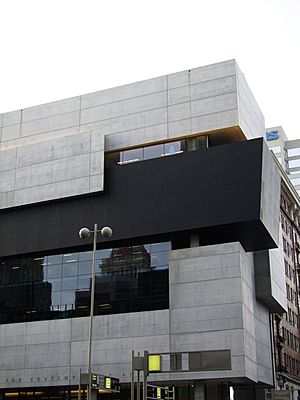Contemporary Arts Center facts for kids
 |
|
| Established | 1939 |
|---|---|
| Location | 44 E. 6th Street Cincinnati, Ohio, United States |
The Contemporary Arts Center (often called CAC) is a special art museum in Cincinnati, Ohio. It's one of the very first places in the United States dedicated to showing contemporary art, which means art made in our time. The CAC doesn't collect art to keep forever. Instead, it focuses on showing new and exciting art, like paintings, sculptures, photos, and even performance art. It's known for displaying works by artists who later became very famous, such as Andy Warhol, early in their careers. In 2003, the CAC moved into a cool new building designed by a famous architect named Zaha Hadid.
Contents
History of the CAC
The Contemporary Arts Center started in 1939. It was first called the Modern Art Society. Three women, Betty Pollak Rauh, Peggy Frank Crawford, and Rita Rentschler Cushman, founded it. They raised money to show modern art at the Cincinnati Art Museum.
Their very first art show, "Modern Painting from Cincinnati Collections," opened in December 1939. In 1954, the Modern Art Society changed its name to the Contemporary Arts Center. This change happened when the museum got two new permanent art galleries. These spaces were designed by Carl Strauss and Ray Roush.
In 1962, the CAC had to move out of the Cincinnati Art Museum. This was because the art museum needed more space. For a while, the CAC moved to different places. It was at the Taft Museum of Art, then on Main Street, and later in the Carew Tower.
In 1964, the CAC found a home on West Fourth Street for six years. Then, in 1970, it moved to the Mercantile Center on Fifth Street. This new building cost $400,000 and was designed by Harry Weese. The CAC had a large space there, about 12,000 square feet.
Even with some money problems in 1971, the CAC held over 400 art shows during its 30 years at the Mercantile Center. In 1982, the city helped the CAC get a permanent lease for that spot.
By the late 1980s, people started thinking about a new home for the CAC. They looked at different places. Eventually, the idea of building a brand new, stand-alone building became possible. The CAC decided on a spot at Sixth and Walnut streets.
In 1997, the CAC began looking for architects to design its first own building. They looked at many famous architects. In 1998, they chose Zaha Hadid to design the new center. Construction began in 2001, and the exciting new building opened on May 31, 2003.
Art Projects and Exhibitions
The CAC often shows interesting art projects. In 1988, they put a sculpture called Metrobot by Nam June Paik outside their building. It stayed there even after the CAC moved. In 2009, it was put into storage, but in 2014, Metrobot was put back on display outside the Walnut Street location.
In 2008, the Contemporary Arts Center held an exhibition and auction called "FORM: Contemporary Architects at Play." This show featured designs from famous architects.
Some of the architects who took part included:
- Peter Eisenman
- Michael Graves
- Zaha Hadid
- Thom Mayne
- Bill Pedersen
- Laurinda Spear
- Bernard Tschumi
- Jaime Velez
- Massimo Vignelli
- Buzz Yudell
Eight pieces and one idea were sold at an auction by Christie's. They raised $425,000 for the CAC.
Location of the CAC
The Contemporary Arts Center is located at 44 East 6th Street in Cincinnati, Ohio. This is at the corner of 6th and Walnut streets. It's right across Walnut Street from the Aronoff Center for the Arts. This area is part of downtown Cincinnati's cultural and entertainment district, known as the Backstage District.
Architecture of the Building
In 2003, the CAC moved into its very first building that was built just for them. This amazing building was designed by Zaha Hadid. The CAC decided to name the building the Lois and Richard Rosenthal Center for Contemporary Art to honor two important donors.
The Rosenthal Center for Contemporary Art was the first building Zaha Hadid designed in the United States. A famous architecture critic from The New York Times called it "the most important American building to be completed since the cold war." The idea for this special building came from the CAC's director at the time, Charles Desmarais.
The building covers about 11,000 square feet on the ground, but it has seven floors, making its total area about 80,000 square feet. The whole project cost $34 million. It has unique design parts that architects call "Urban Carpet," "Jigsaw Puzzle," and "Skin/Sculpture."
Awards for the Building
The building has won several awards for its design:
- 2004 Royal Institute of British Architects (RIBA) Award
- 2005 American Architecture Award from The Chicago Athenaeum
See also
 In Spanish: Centro de Arte Contemporáneo Rosenthal para niños
In Spanish: Centro de Arte Contemporáneo Rosenthal para niños

